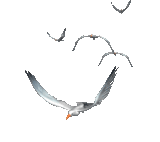Most of these seabirds are carnivorous fish eaters, a few are just carnivorous. Feeding techniques include plunge diving, swimming to pursue prey,  surface feeding and piratical behaviors. Some are opportunistic feeders and some have become scavengers.
surface feeding and piratical behaviors. Some are opportunistic feeders and some have become scavengers.  They are a group of aquatic predators which have evolved with various characteristics, which enable them to become specialists in catching different kinds of prey. In some cases, seabirds which are totally unrelated & are found in different oceans of the world, have evolved to look and behave very much like each other.
They are a group of aquatic predators which have evolved with various characteristics, which enable them to become specialists in catching different kinds of prey. In some cases, seabirds which are totally unrelated & are found in different oceans of the world, have evolved to look and behave very much like each other.
Penguins
They became flightless with their wings becoming flippers to propel them through the sea. Their feet are so far back on the body that they stand upright on land. The earlier versions of these birds were becoming extinct because they were unable to compete with other fish eaters. About this time, the King & Emperor Penguins diverged and became the group which are now our modern Penguins. They are now only found in the Southern Hemisphere on the southern coasts of Australia, New Zealand, South Africa, South America and throughout Antarctica.
Auks, Murres, Razorbills & Puffins
These birds are very similar in body form to the Penguins, especially when seen swimming in the sea. Unlike the Penguins however, they have retained the ability to fly. They are found in coastal areas of the Northern Hemisphere whereas Penguins are found in coastal areas of the Southern Hemisphere. Puffins tend to be on the grassy slopes at the top of the cliffs.
Tubenoses
Tubenoses include the Albatross, Petrels and Shearwaters. Albatrosses are found in the Pacific, Indian and Southern oceans. Petrels, Shearwaters, Storm Petrels and Giant Petrels are widespread. They are found in the Southern Ocean and in the North Atlantic Ocean and high Arctic region where they nest in large colonies in crevices on elevated slopes.
Gannets & Boobies
Gannets and Boobies are seabirds which have taken “plunge diving” to a new level. Gannets favor coastal areas while Boobies favor island coasts. Both are found in the Pacific, Indian & Atlantic Oceans.
Pelicans
Pelicans are large birds that are most well known for the pouch that it has in it’s beak, which the Pelican uses to scoop fish out if the water. The Pelican is found in the countryside worldwide, dwelling near water and densely populated fishing areas.
Tropicbirds
Tropicbirds are only found in the Tropical Oceans. They plunge dive taking prey with their dagger beaks. These birds breed on oceanic islands, laying their eggs in crevices on the ground or under overhanging rocks.
Terns
Terns found both open and inland waters. In appearance, they closely resemble the Tropicbirds. Some Terns hover before taking their prey just below the water surface.
Skimmers
Skimmers have surely evolved from the Terns. They hollow out a nest in the sand using their feet and body pressure. They fly close to the water surface using their lower mandible, which is longer than the upper one to plough through the water. When it touches a fish, the beak snaps shut.
Frigatebirds
Frigatebirds are piratical scavengers and are found in the tropical Pacific, Atlantic, Indian Oceans.
Gulls
The smaller-size Gulls tend to be surface feeders while the larger Gulls have become scavengers taking whatever food is available, both at sea and on land.
Skuas & Jaegers
They look like the Gulls but are very powerful and aggressive, dominating all other seabirds in their vicinity.